The Carmine Maggiore Bell Tower: An Inclusive and Sustainable Restoration Experience
Abstract
1. Introduction
2. Materials and Methods
2.1. Historical Notes
2.2. Geometric and Diagnostic Survey of the Bell Tower
3. Results: The Inclusive and Sustainable Restoration Project
3.1. Restoration Project
- Binocular stereo-microscope observation, aimed at verifying the representativity of samples and performing the first characterization of their surface morphology;
- Stratigraphic study on polished cross-sections, where the sample was incorporated in polyester resin for obtaining a section perpendicular to the external surface; the samples were observed under a microscope in reflected light, white and ultraviolet, to identify nature, thickness, and layers sequence [38].
- Histochemical test on polished sections with “Black Starch (AB II) and Red Oil”, aimed at determining the class of any organic compounds [40].
- Fourier transform infrared spectrophotometry for recognizing both synthetic and natural organic compounds and inorganic compounds related to constituent materials and degradation. The spectra were acquired using the KBr Pellet Method, in the range of 4000–400 cm−1, and resolution of 4 cm−1.
- (i)
- The fragments of natural stones taken from cornices showed a greyish coloring and a saccharoid appearance on the crack surface.
- (ii)
- The fragments of artificial stone materials (mortars and plasters) taken from the lower and the upper part of the bell tower, both from the fake brick finishing and near it showed similar compositional and texture characteristics.
- (iii)
- The mortar samples showed that the mortar was made of aerial lime mixed with pozzolanic sand in a ratio of about 1:2 in volume, characterized by arenaceous grain size, ranging between 0.2 and 0.5 mm. The aggregate was mainly effusive volcanic rocks and pumice lapilli, with few isolated crystals of feldspars, pyroxenes, and leucite, also resulting from the decomposition of volcanic litho-types. The presence of a modest quantity of earthy material testified to a low sifting of the sand.
- (iv)
- The plaster samples showed porosity around 10–15% in volume. The binder/aggregate ratio was close to 2:1 in volume. The subgrade plaster was made of aerial lime mixed with pozzolanic sand of a predominantly medium-fine arenaceous sand grain size (0.2–0.45 mm).
- (v)
- Two samples of layers of red paint, about 80–150 μm thick, showed iron oxides (hematite) and traces of quartz as mineral filler.
3.2. The Structural Project
- 1
- The integration of the strand tie rods with new stainless steel tie rods: 30 mm diameter stainless steel tie rods were arranged, anchored to the masonry walls through stainless steel plates. Each tie rod was protected by a Teflon wrap, and the portion passing through the masonry walls was covered with a PVC tubular to allow sliding and for future maintenance.
- 2
- The strengthening of mortar joints: weak and inconsistent parts, with disaggregating grains, dust, and mold was removed from the mortar joints until healthy and compact support was obtained. Subsequently, a low-pressure deionized water wash was carried out to eliminate any efflorescence and soluble salts from the surface and to prevent any water being removed from the restoration grout, compromising the final performance characteristics. Finally, a fiber-reinforced lime mortar was spread, sometimes in several layers. The mortar had the following main composition: an aggregate of max 3 mm natural siliceous sand in 1:3 by weight, a lime binder with a density of about 2.5 g/mL and Ca(OH)2 content of 75%; the cellulose of medium length as fibrous materials in 1% by weight of the binder. The mortar had compensated shrinkage, high protection, and durability, physical-mechanical characteristics similar to the existing one (compressive strength of 5–7 N/mm2), and was made by a binder-free from cement and water-soluble salts.
- 3
- The cracks repair: the cracks were refilled with structural mortar, sometimes improved with aggregates, to restore the masonry continuity and provide an effective interlocking. A fiber-reinforced thixotropic hydraulic lime mortar with volumetric stability, super-adhesive, compensated shrinkage, low soluble salt content (less than 10 ppm), suitable grain color, was used to avoid any risk of aggression to the existing masonry. The mortar had the same main composition as the one used to strengthen the mortar joints, but a compressive strength of 10–12 N/mm2 (NHL5 natural hydraulic lime, M10 class, fully cement-free). The choice of this hydraulic lime mortar was due to the requirement to contain the excessive erosion caused by the exposure of the bell tower to the sea. Mortars were used to restore the masonry to its original strength. The cracks were initially slightly widened by breaking the surrounding bricks with a sharp tool and being thoroughly cleaned with compressed air or with a brush. Subsequently, the substrate was treated to allow for effective adhesion of the structural mortar to the brick/stone. A protective nanometric consolidating agent was used: it was natural inorganic, based on calcium hydroxide in a saturated solution, free from synthetic additives and organic components, coming from the filtration of water used for the processing of slaked lime. Therefore, the product was breathable, did not form efflorescence, was a natural antibacterial, totally non-toxic, and ecological. Subsequently, on the still fresh consolidant primer, the crack was filled with the structural mortar. The application was carried out by trowel or jointing machine, taking care to make the mortar penetrate perfectly inside the crack, occluding all the voids and in perfect adherence with bricks and stones. A few millimeters of mortar were also spread on the jagged edges of the crack.
- 4
- The filling of niches, cavities, and voids in masonry walls: the degraded stones and bricks surrounding niches or cavities were removed. The filling of niches and the masonry rebuilding were performed using elements of geometry (shape and size) and mechanical characteristics similar to the original ones, using a mortar with zero shrinkage or slightly expansive (Figure 10a).
- 5
- The anti-rust treatment of the tie-rods of the late nineteenth and early twentieth century, and the replacement of the degraded steel anchoring cramps: the old cramps were replaced by injection “anchors with sock”. Stainless steel bars of 12 mm diameter were anchored for 600 mm in holes using a polyester sock, filled with a specific hydraulic mortar through an appropriate system of injection pipes. The sock, gradually filled, adapted to the geometry of the hole, ensuring the anchorage of the bar to the masonry, avoiding dispersion of material in voids and cavities, and even distribution of stresses in the masonry. Each anchorage was completed with a small stainless steel plate placed slightly under the masonry surface (Figure 10b).
- 6
- The restoration of oxidized metal elements: the accessible and not notably degraded steel elements were treated by sandblasting at a pressure between 300 and 500 KPa, to remove rust until a visible metal cleaning was obtained. Subsequently, the oxidation process was inhibited through passivating chemical products, using oily inhibitors, and ferromicaceous paints (Figure 10c).
- 7
- The strengthening of timber structures: degraded but recoverable timber beams were consolidated and protected by both simple impregnation and surface crack filling, using specific impregnating agents of fluid consistency and high chemical-physical compatibility with the existing wood. Where necessary, bolted stainless steel ties were arranged. The unrecoverable timber elements were replaced by elements of similar mechanical characteristics.
- 8
- The motion control of bells: engine brakes to inhibit excessive motions of bells during any seismic events were installed in the belfry.
3.3. The Lighting Project
4. Discussion
5. Conclusions
Author Contributions
Funding
Institutional Review Board Statement
Informed Consent Statement
Data Availability Statement
Acknowledgments
Conflicts of Interest
References
- Leucci, G. Nondestructive Testing for Archaeology and Cultural Heritage: A Practical Guide and New Perspectives; Springer Nature: Berlin/Heidelberg, Germany, 2019. [Google Scholar]
- Van Grieken, R.; Janssens, K. Cultural Heritage Conservation and Environmental Impact Assessment by Non-Destructive Testing and Micro-Analysis; CRC Press: Boca Raton, FL, USA, 2004. [Google Scholar]
- Bertolin, C. Preservation of Cultural Heritage and Resources Threatened by Climate Change. Geosciences 2019, 9, 250. [Google Scholar] [CrossRef]
- Sarhosis, V.; Milani, G.; Formisano, A.; Fabbrocino, F. Evaluation of different approaches for the estimation of the seismic vulnerability of masonry towers. Bull. Earthq. Eng. 2017, 16, 1511–1545. [Google Scholar] [CrossRef]
- Palermo, M.; Silvestri, S.; Gasparini, G.; Baraccani, S.; Trombetti, T. An approach for the mechanical characterisation of the Asinelli Tower (Bologna) in presence of insufficient experimental data. J. Cult. Herit. 2015, 16, 536–543. [Google Scholar] [CrossRef]
- Bergamasco, I.; Gesualdo, A.; Iannuzzo, A.; Monaco, M. An integrated approach to the conservation of the roofing structures in the Pompeian domus. J. Cult. Herit. 2018, 31, 141–151. [Google Scholar] [CrossRef]
- Guadagnuolo, M.; Faella, G.; Donadio, A.; Ferri, L. Integrated evaluation of the Church of S. Nicola di Mira: Conservation versus safety. NDT E Int. 2014, 68, 53–65. [Google Scholar] [CrossRef]
- Gesualdo, A.; Iannuzzo, A.; Monaco, M.; Penta, F. Rocking of a rigid block freestanding on a flat pedestal. J. Zhejiang Univ. Sci. A 2017. [Google Scholar] [CrossRef]
- Guadagnuolo, M.; Aurilio, M.; Tafuro, A.; Faella, G. Analysis of Local Mechanisms through Floor Spectra for the Preservation of Historical Masonries. A Case Study. In Proceedings of the 7th International Conference on Computational Methods in Structural Dynamics and Earthquake Engineering, Crete, Greece, 24–26 June 2019. [Google Scholar]
- Bartoli, G.; Betti, M.; Galano, L.; Zini, G. Numerical insights on the seismic risk of confined masonry towers. Eng. Struct. 2019, 180, 713–727. [Google Scholar] [CrossRef]
- Valente, M.; Milani, G. Effects of geometrical features on the seismic response of historical masonry towers. J. Earthq. Eng. 2017, 22 (Suppl. 1), 1–33. [Google Scholar] [CrossRef]
- MIT. Norme Tecniche per le Costruzioni; D.M. 17.01.2018; Official Bulletin: Rome, Italy, 2018. [Google Scholar]
- MIT. Valutazione e Riduzione del Rischio Sismico del Patrimonio Culturale con Riferimento Alle Norme Tecniche per le Costruzioni di cui al Decreto del Ministero Delle Infrastrutture e dei Trasporti del 14 Gennaio 2008; Direttiva, P.C.M. 9 Febbraio 2011; Official Bulletin: Rome, Italy, 2011. [Google Scholar]
- Preciado, A.; Santos, J.C.; Silva, C.; Ramirez-Gaytan, A.; Falcon, J.M. Seismic damage and retrofitting identification in unreinforced masonry Churches and bell towers by the September 19, 2017 (Mw = 7.1) Puebla-Morelos Earthquake. Eng. Fail. Anal. 2020, 118, 104924. [Google Scholar] [CrossRef]
- Bartoli, G.; Betti, M.; Monchetti, S. Seismic risk assessment of historic masonry towers: Comparison of four case studies. J. Perform. Constr. Facil. 2017, 31, 10. [Google Scholar] [CrossRef]
- Pena, F.; Lourenco, P.B.; Mendes, N.; Oliveira, D.V. Numerical models for the seismic assessment of an old masonry tower. Eng. Struct. 2010, 32, 1466–1478. [Google Scholar] [CrossRef]
- Ferraioli, M.; Lavino, A.; Abruzzese, D.; Avossa, A.M. Seismic Assessment, Repair and Strengthening of a Medieval Masonry Tower in Southern Italy. Int. J. Civ. Eng. 2020, 18, 967–994. [Google Scholar] [CrossRef]
- Guadagnuolo, M.; Nuzzo, M.; Faella, G. The Corpus Domini Bell Tower: Conservation and Safety. In Proceedings of the XIV International Conference on Building Pathology and Constructions Repair—CINPAR 2018, Firenze, Italy, 20–22 June 2018. [Google Scholar] [CrossRef]
- Formisano, A.; Milani, G. Seismic Vulnerability Analysis and Retrofitting of the SS. Rosario Church Bell Tower in Finale Emilia (Modena, Italy). Front. Built Environ. 2019, 5, 70. [Google Scholar] [CrossRef]
- Acito, M.; Chesi, C.; Milani, G.; Torri, S. Collapse analysis of the Clock and Fortified towers of Finale Emilia, Italy, after the 2012 Emilia Romagna seismic sequence: Lesson learned and reconstruction hypotheses. Constr. Build. Mater. 2016, 115, 193–213. [Google Scholar] [CrossRef]
- Marra, A.M.; Salvatori, L.; Spinelli, P.; Bartoli, G. Incremental dynamic and nonlinear static analyses for seismic assessment of Medieval Masonry Towers. ASCE J. Perform. Constr. Facil. 2017, 31, 1–10. [Google Scholar] [CrossRef]
- Milani, G.; Casolo, S.; Naliato, A.; Tralli, A. Seismic assessment of a medieval masonry tower in northern Italy by limit, nonlinear static, and full dynamic analyses. Int. J. Archit. Herit. 2011, 6, 37–41. [Google Scholar] [CrossRef]
- Valente, M.; Milani, G. Non-linear dynamic and static analyses on eight historical masonry towers in the North-East of Italy. Eng. Struct. 2016, 114, 241–270. [Google Scholar] [CrossRef]
- Ferraioli, M.; Miccoli, L.; Abruzzese, D.; Mandara, A. Dynamic characterisation and seismic assessment of medieval masonry towers. Nat. Hazards 2017, 86, 489–515. [Google Scholar] [CrossRef]
- Ubertini, F.; Comanducci, G.; Cavalagli, N.; Pisello, A.L.; Materazzi, A.L.; Cotana, F. Environmental effects on natural frequencies of the San Pietro bell tower in Perugia, Italy, and their removal for structural performance assessment. Mech. Syst. Signal Process. 2017, 82, 307–322. [Google Scholar] [CrossRef]
- De Silva, F.; d’Onofrio, A.; Evangelista, L.; Fascia, F.; Silvestri, F.; Scotto di Santolo, A.; Sica, S.; Cavuoto, G.; Di Fiore, V.; Punzo, M.; et al. Application of ERT and GPR Geophysical Testing to the Geotechnical Characterization of Historical Sites. In Proceedings of the 20th IMEKO TC4 International Symposium and 18th Int. Workshop on ADC Modelling and Testing Research on Electric and Electronic Measurement for the Economic Upturn, Benevento, Italy, 15–17 September 2014. [Google Scholar]
- Moscarella, P.T. Chronistoria del Carmine Maggiore di Napoli, scritta da da Pier Tommaso Moscarella, dal 1589 e Continuato Fino al 1825; Section Misc.X AA2; National Library of Naples: Napoli, Italy, 1825. [Google Scholar]
- Filangieri, G. Chiesa e convento del Carmine Maggiore in Napoli. Descrizione storica ed artistica. In Documenti per la Storia le Arti e le Industrie Delle Provincie Napoletane; Tipografia dell’Accademia Reale delle Scienze Diretta da Michele De Rubertis: Napoli, Italy, 1885. [Google Scholar]
- Ceroni, F.; Pecce, M.; Palmaccio, F.; Manfredi, G. Structural investigations and modelling of the Bell Tower of Santa Maria del Carmine. Structural Studies, Repairs and Maintenance of Heritage Architecture. In WIT Transactions on The Built Environment; WIT Press: Southampton, UK, 2007; Volume 95. [Google Scholar]
- Ceroni, F.; Pecce, M.; Voto, S.; Manfredi, G. Historical, architectural, and structural assessment of the bell tower of Santa Maria del Carmine. Int. J. Archit. Herit. 2009, 3, 169–194. [Google Scholar] [CrossRef]
- De Silva, F.; Silvestri, F.; Ceroni, F.; Sica, S.; Pecce, M.R. Experimental and Numerical Dynamic Identification of Carmine Bell Tower in Naples (Italy). In Proceedings of the 4th International Workshop on Archeology, Cryptoportici, Hypogea, Geology, Geotechnics, Rome, Italy, 12–13 November 2015. [Google Scholar]
- De Silva, F.; Ceroni, F.; Sica, S.; Silvestri, F. Non-linear analysis of the Carmine bell tower under seismic actions accounting for soil–foundation–structure interaction. Bull. Earthq. Eng. 2018, 16, 2775–2808. [Google Scholar] [CrossRef]
- Voto, S. Seismic Retrofitting and Restoration of Historical Buildings Using Innovative Materials: The Case of Carmine’s Bell Tower in Naples. Ph.D. Thesis, University of Naples Federico II, Napoli, Italy, 2009. [Google Scholar]
- Montuori, M. Campanile della Basilica del Corpus Domini. In Architettura e Preesistenze; Balzani, M.R., Ed.; Dalla University of Naples Federico Negra: Milan, Italy, 2017; pp. 124–127. [Google Scholar]
- Binda, L.; Gambarotta, L.; Lagomarsino, S.; Modena, C. A multilevel approach to the damage assessment and seismic improvement of masonry buildings in Italy. In Seismic Damage to Masonry Buildings; Balkema: Rotterdam, The Netherlands, 1999; pp. 170–195. [Google Scholar]
- Magenes, G.; Penna, A.; Senaldi, I.E.; Rota, M.; Galasco, A. Shaking table test of a strengthened full-scale stone masonry buildings with flexible diaphragms. Int. J. Archit. Herit. 2014, 8, 349–375. [Google Scholar] [CrossRef]
- Dalla Negra, R. Il restauro consapevole: La traduzione dei principi conservativi e il difficile rapporto con le preesistenze. In Restauro, Recupero e Riqualificazione. Il Progetto Contemporaneo nel Contesto Storico; Skira: Milan, Italy, 2011; pp. 15–19. [Google Scholar]
- Italian National Research Center (CNR); Higher Institute for Conservation and Restoration (ICR). Normal 14/83: Sezioni Sottili e Lucide di Materiali Lapidei: Tecnica di Allestimento; CNR; ICR: Roma, Italy, 1983. [Google Scholar]
- Italian Standardization Company (UNI). Petrographic Description of Mortars; UNI 11176:2006; UNI: Milan, Italy, 2006. [Google Scholar]
- Higher Institute for Conservation and Restoration (ICR). DIMOS Parte I—Modulo 3: Leganti-Fissativi-Pigmenti Metodi di Riconoscimento; Istituto Centrale del Restauro: Roma, Italy, 1978. [Google Scholar]
- Lancaster, J. In the Shadow of Vesuvius: A Cultural History of Naples; Bloomsbury USA: New York, NY, USA, 2005. [Google Scholar]
- Midas FEA. Advanced Nonlinear and Detail Program. Analysis and Algorithm. 1989. Available online: https://en.midasuser.com/product/fea_overview.asp (accessed on 20 August 2016).
- Luciano, R.; Sacco, E. Homogenization technique and damage model for old masonry material. Int. J. Solids Struct. 1997, 34, 3191–3208. [Google Scholar] [CrossRef]
- Pande, G.N.; Liang, J.X.; Middleton, J. Equivalent elastic moduli for brick masonry. Comput. Geotech. 1989, 8, 243–265. [Google Scholar] [CrossRef]
- Lee, J.S.; Pande, G.N.; Middleton, J.; Kralj, B. Numerical modeling of brick masonry panels subject to lateral loadings. Comput. Struct. 1996, 61, 735–745. [Google Scholar] [CrossRef]
- Longobardi, L. Una Fortificaciòn Anomala: El Castillo del Carmen in Castillos de España; Nº 145; DialNet: Logroño, Spain, 2007; pp. 37–46. ISSN 0008-7505. [Google Scholar]
- North, J. Nelson at Naples: Revolution and Retribution in 1799; Amberley Publishing Edt.: Stroud, UK, 2018. [Google Scholar]
- Colletta, P.; Davis, J.A.; Horner, S. The History of the Kingdom of Naples: From the Accession of Charles of Bourbon to the Death of Ferdinand I; Tauris Academic Studies: New York, NY, USA, 2009. [Google Scholar]
- Midon, F. The History of the Rise and Fall of Masaniello the Fisherman of Naples; Book on Demand Ltd.: London, UK, 2013. [Google Scholar]
- Giglioli, C.H.D.; Hamilton, W. Naples in 1799: An Account of the Revolution of 1799 and of the Rise and Fall of the Parthenopean Republic; Wentworth Press: London, UK, 2016. [Google Scholar]
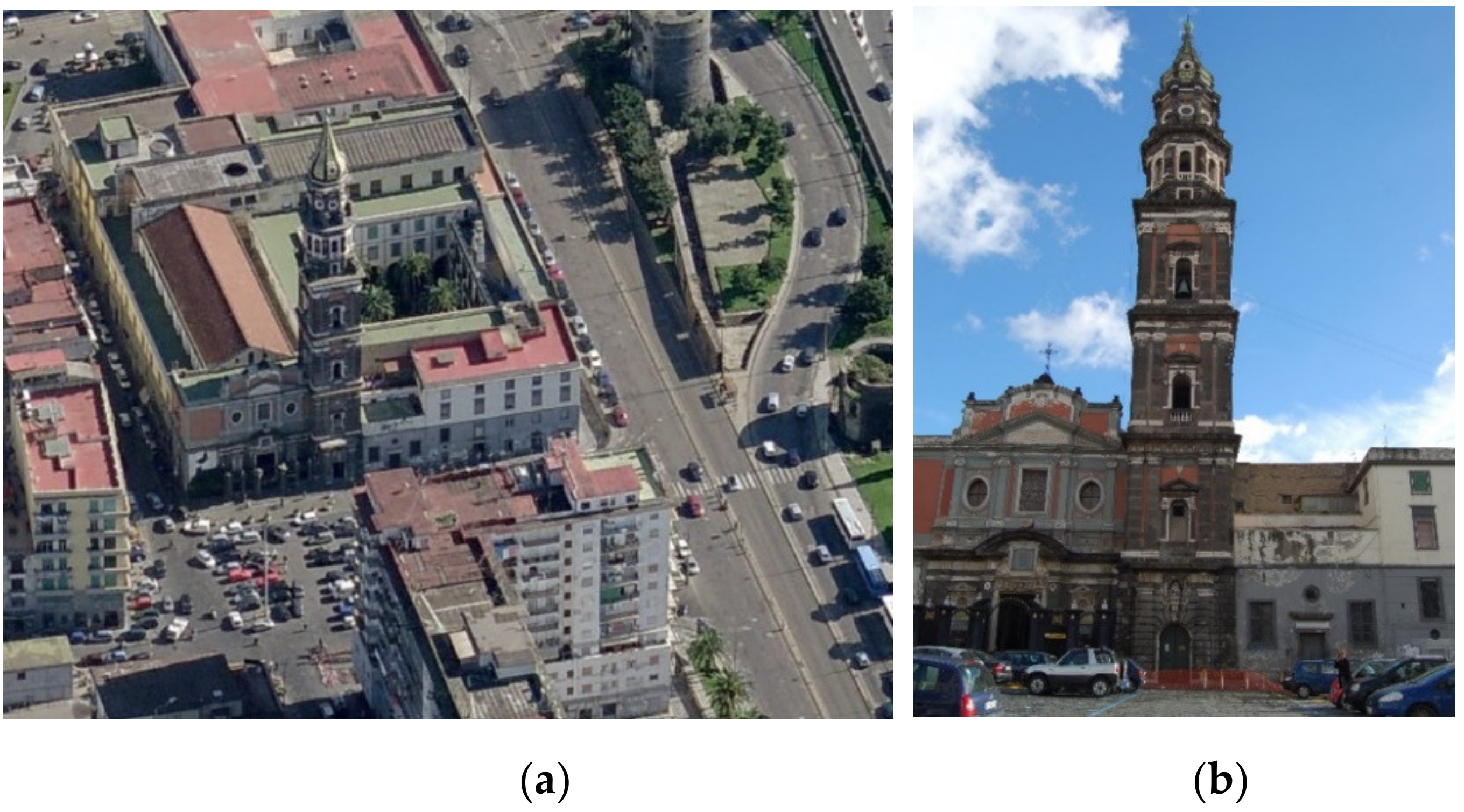
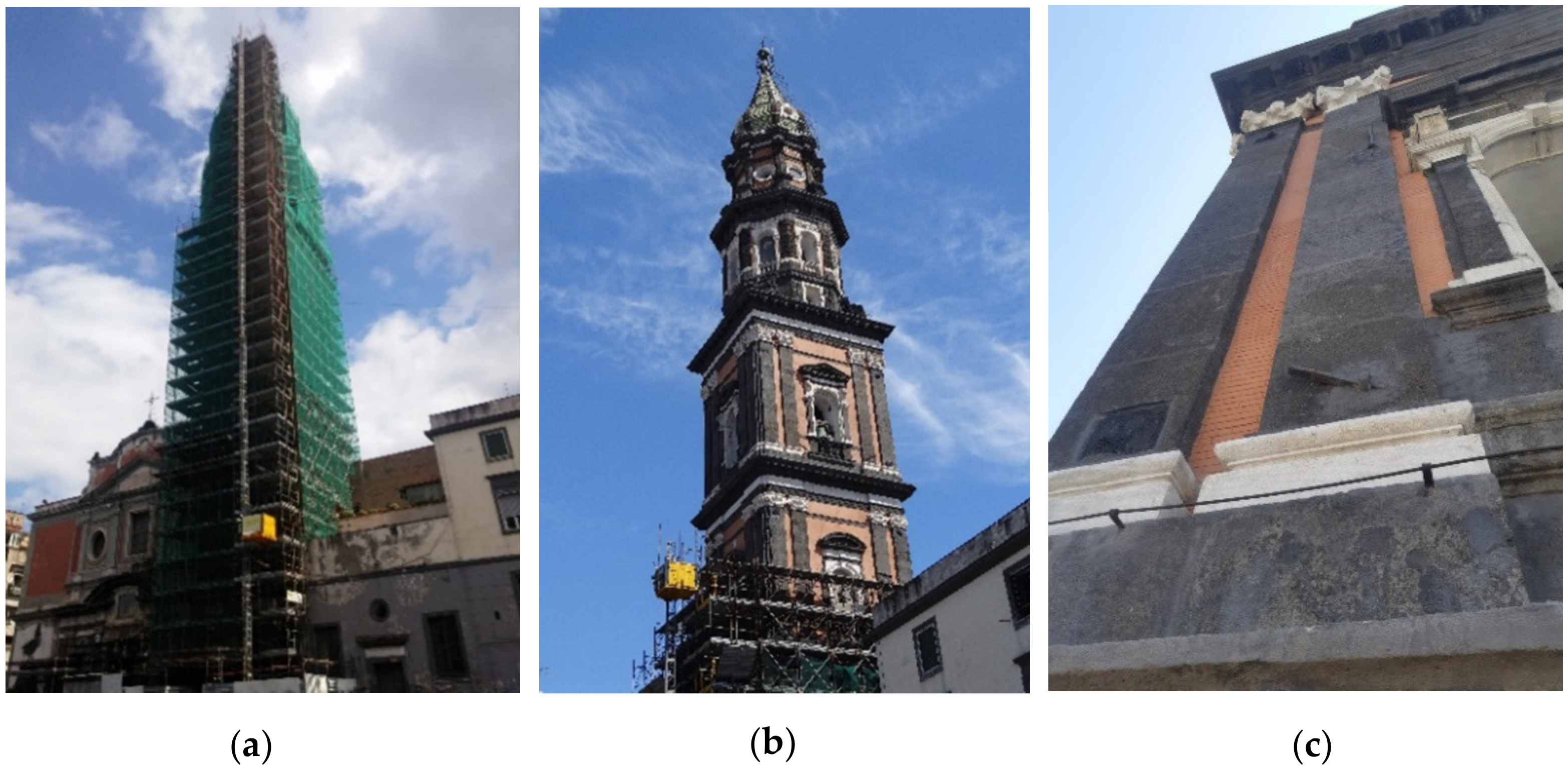
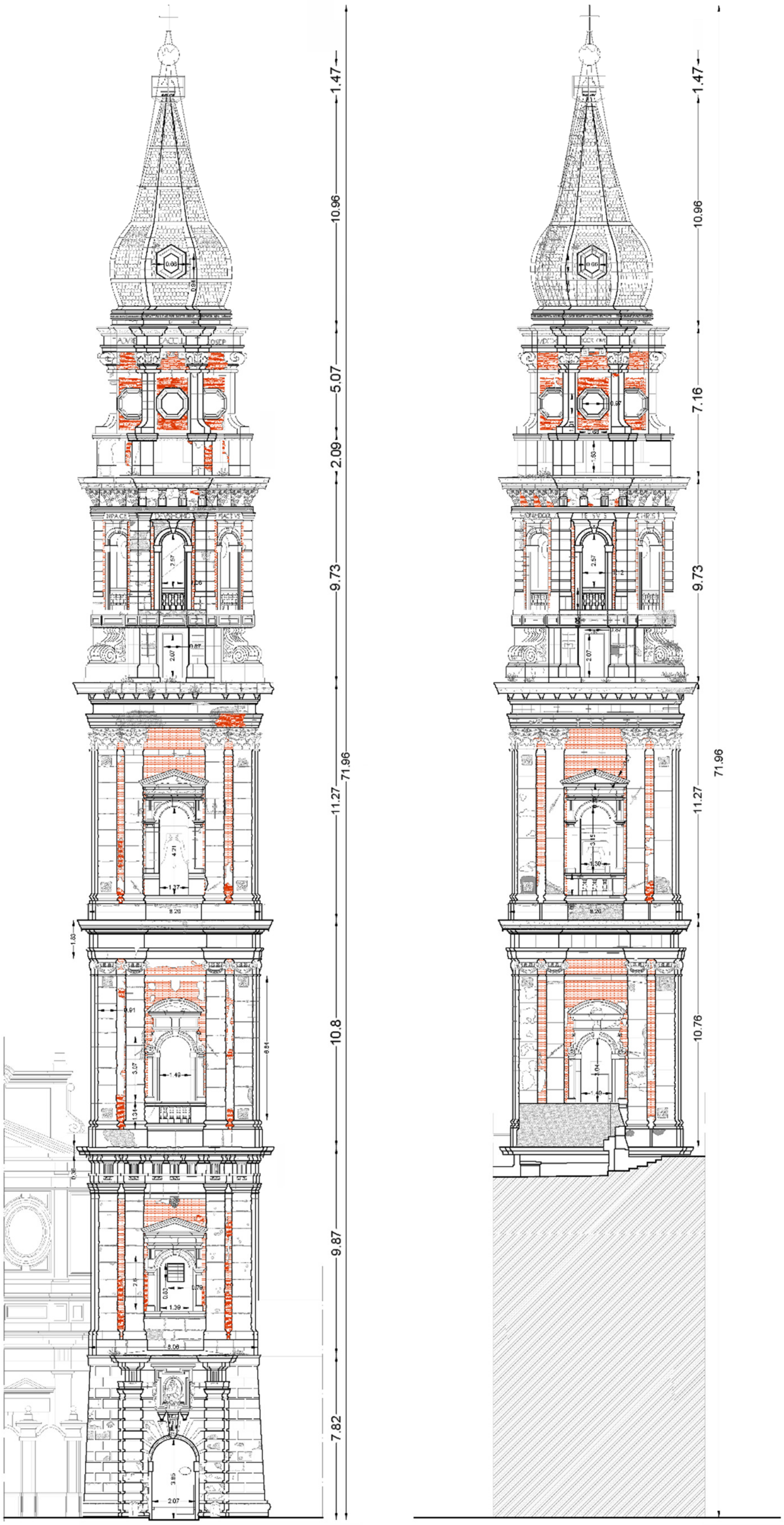
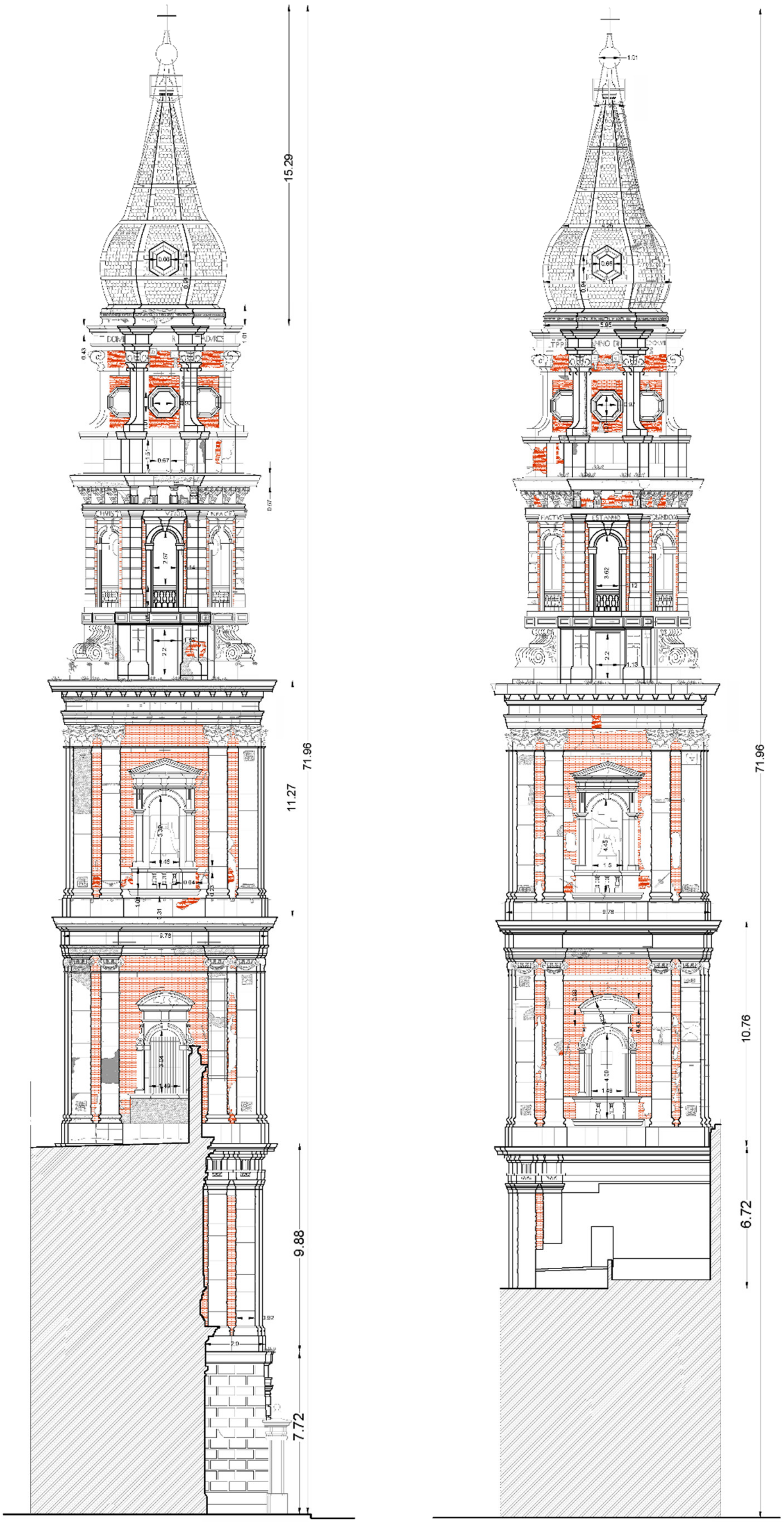


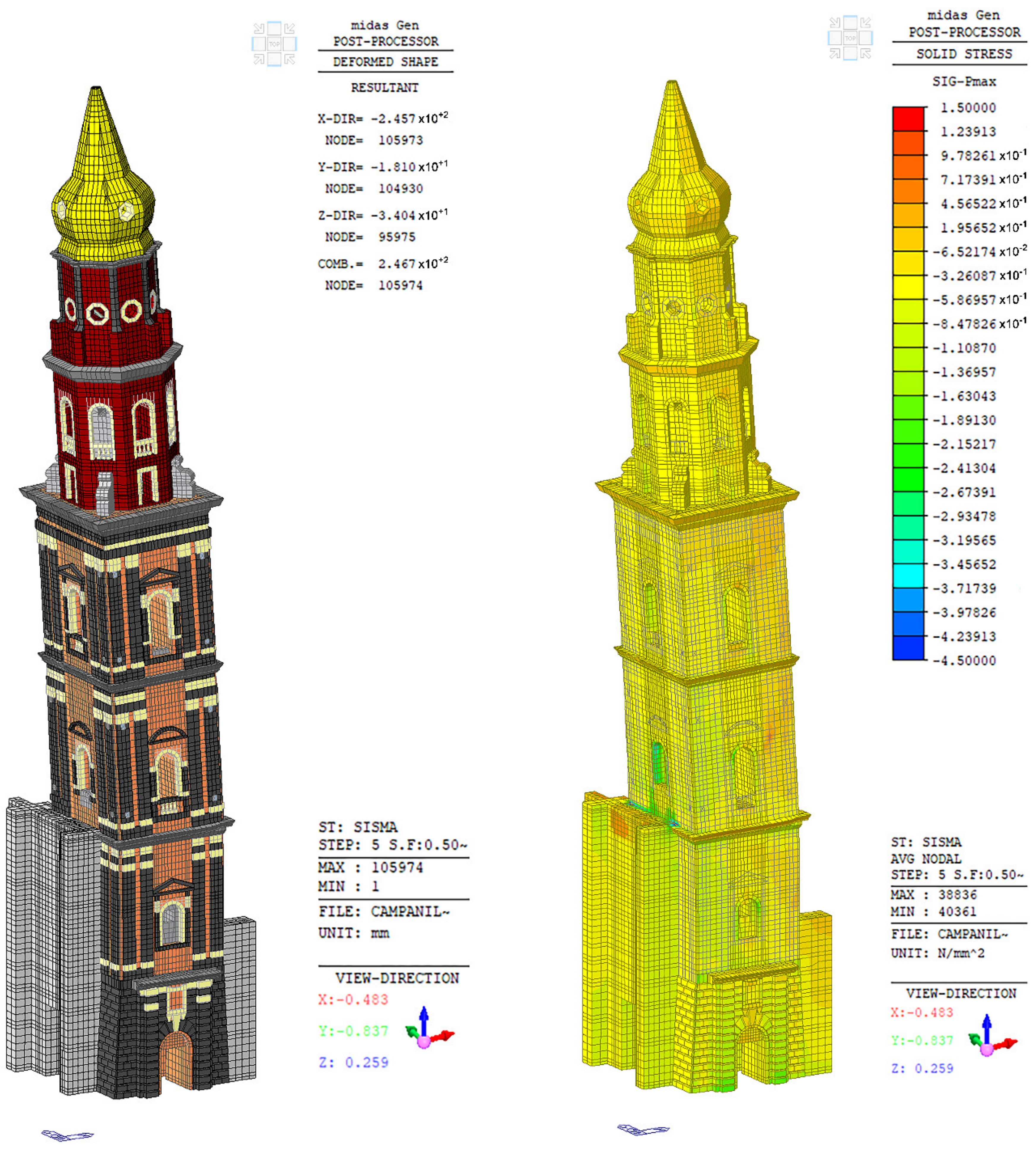
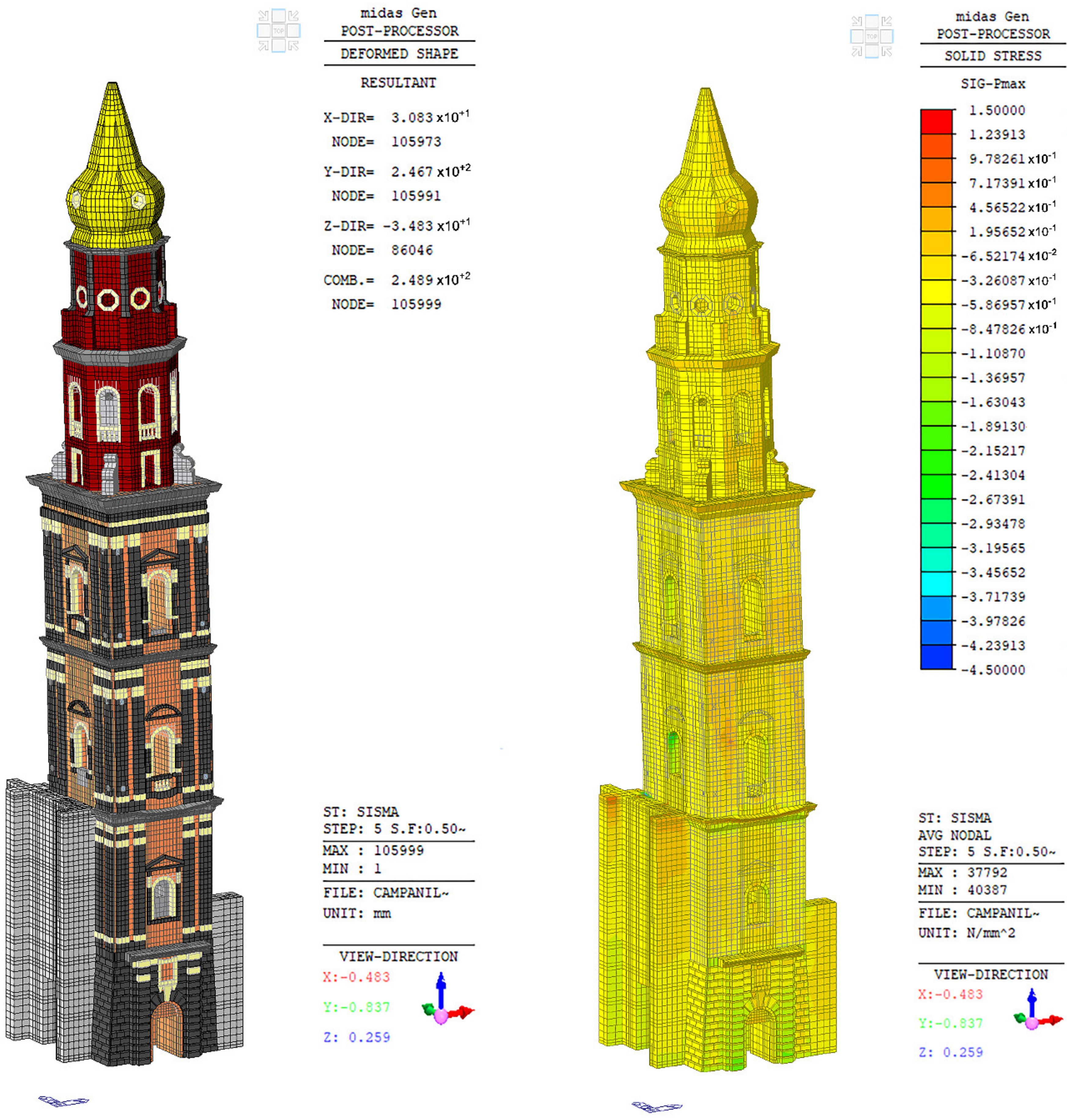
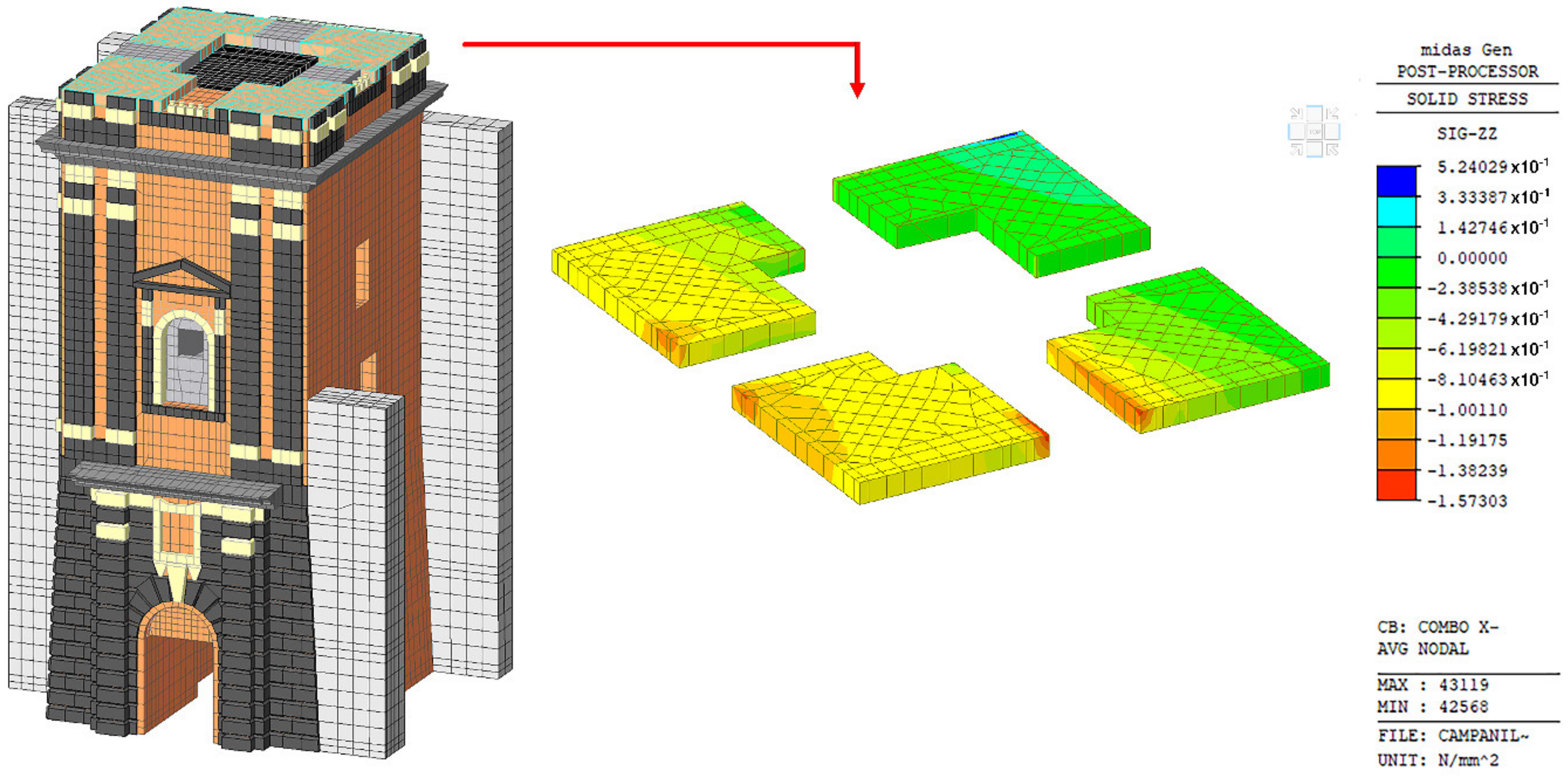

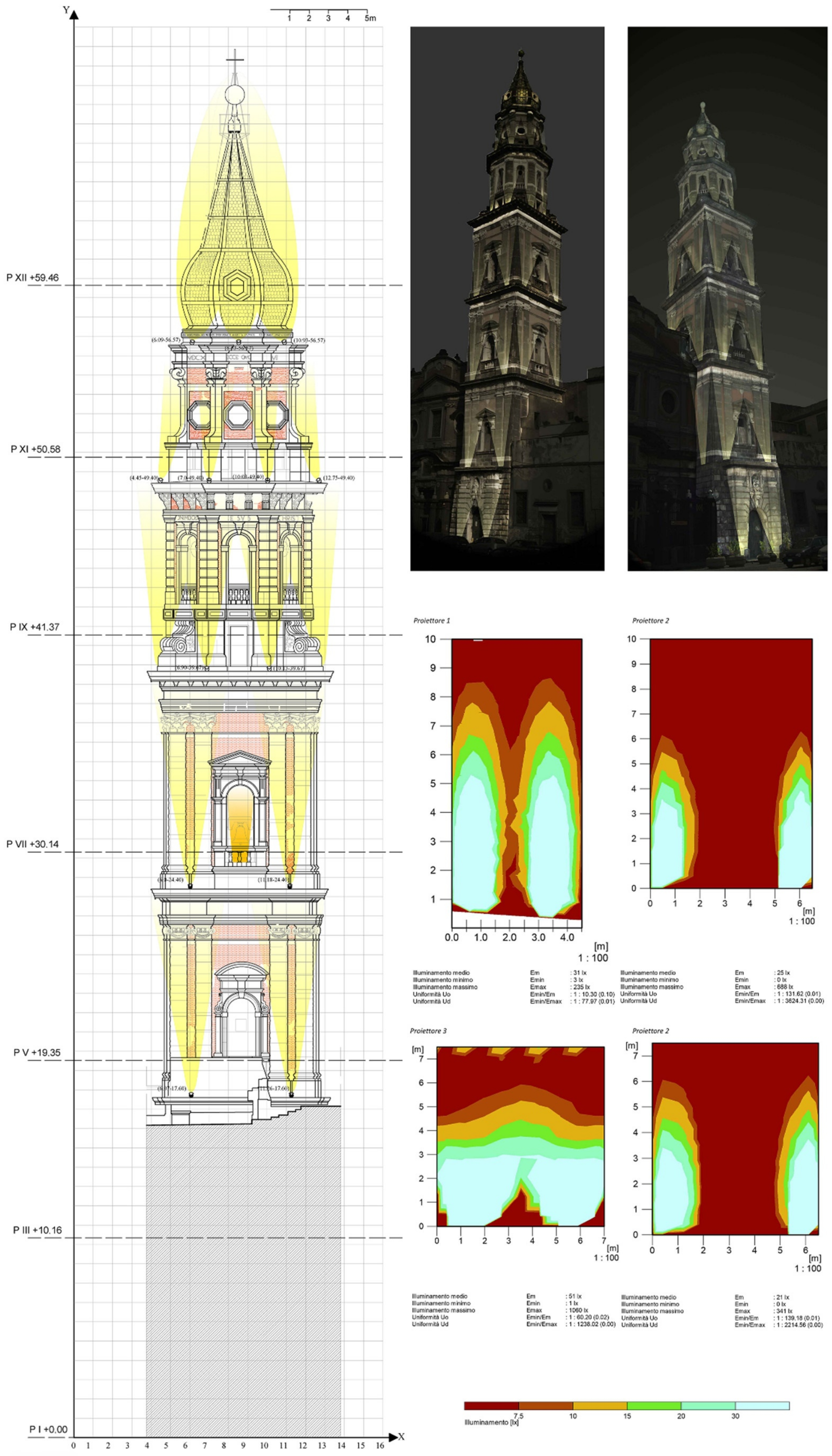
| Coulour | Materials | Degradation | Causes | Interventions |
|---|---|---|---|---|
 | Brickwork | Crack and/or fracture | Lack of maintenance Wind action Seepage of water | A.06.170.a—Masonry consolidation A.06.190.a—Consolidation of joints A.11.016.b—Protection of external stones |
| Surface deposit | Lack of maintenance Weather | A.06.020.a—Desalinating treatment of tuff or brick masonry | ||
| Stain | Want of maintenance Particulate deposit | A.06.100.a—Restoration of ancient masonry for restoring cavities | ||
| Encrustation | Humidity Air pollution | A.06.020.a—Desalinating treatment of tuff or brick masonry A.06.160.a—Reintegration of gaps A.06.170.a—Masonry consolidation | ||
| Mortar joints erosion | Polluting substances Weather | A.06.190.a—Consolidation of joints A.06.160.a—Reintegration of gaps | ||
 | Plaster of false curtain wall | Surface deposit | Lack of maintenance Weather | A.10.001.a—Plaster surface cleaning |
| Detachment | Rising moisture Structural cracks | A.10.070.a—Consolidation of plasters in depth | ||
| Crack and/or fracture | Lack of maintenance Wind action Seepage of water | A.10.080.a—Restoration for consolidating and fixing plasters | ||
| Swelling | Different materials expansion Ice formation in surface layers | A.10.080.a—Restoration for consolidating and fixing plasters | ||
| Lack | Weathering erosion Age of material | A.10.090.a—Reintegration of plaster | ||
 | False piperno plaster | Surface deposit | Lack of maintenance Weather | A.10.001.a—Plaster surface cleaning |
| Detachment | Rising moisture Structural cracks | A.10.070.a—Consolidation of plasters in depth | ||
| Crack and/or fracture | Lack of maintenance Wind action Seepage of water | A.10.080.a—Restoration for consolidating and fixing plasters | ||
| Lack | Weathering erosion Age of material | A.10.090.a—Reintegration of plaster | ||
 | Plaster | Surface deposit | Lack of maintenance Weather | A.10.001.a—Plaster surface cleaning |
| Detachment | Rising moisture Structural cracks | A.10.070.a—Consolidation of plasters in depth | ||
| Crack and/or fracture | Lack of maintenance Wind action Seepage of water | A.10.080.a—Restoration for consolidating and fixing plasters | ||
| Lack | Weathering erosion Age of material | A.10.090.a—Reintegration of plaster | ||
| Stain | Biodeteriogens Oxidation of metallic elements Vandalism | A.10.080.a—Restoration for consolidating and fixing plasters | ||
 | “Ambrogette” majolica tiles | Surface deposit | Lack of maintenance Weather | A.14.002.b—Cleaning of ceramics and glasses |
| Crack and/or fracture | Lack of maintenance Wind action Seepage of water | A.14.006.b—Consolidation of detached parts of ceramics | ||
| Presence of vegetation | Humidity Lack of maintenance | A.06.001.a—Removal of moss, lichen and algal layers A.06.010.a—Biocidal disinfesting treatment | ||
 | Iron | Oxidation | Lack of maintenance Weathering erosion Age of material | A.13.029.b—Removal of iron oxides and corroded parts A.13.030.b—Treating with corrosion inhibitors |
| Atmospheric corrosion | Sea aerosol Wind action | A.13.028.b—Cleaning and forced washing of iron and alloys A.13.029.b—Removal of iron oxides and corroded parts | ||
| Lack | Weathering erosion Age of material | NP03—Integration of stranded tie-rods with stainless tie-rods | ||
 | Bronze | Oxidation | Lack of maintenance Weathering erosion Age of material | A.13.014.b—Removal of copper oxides and corrosion A.13.013.b—Cleaning of copper and alloy A.13.018.c—Protection of copper and alloys |
| Atmospheric corrosion | Sea aerosol Wind action | A.13.003.b—Cleaning in presence of copper in silver alloy A.13.014.b—Removal of copper oxides and corrosion A.13.018.c—Protection of copper and alloys | ||
 | Steel | Oxidation | Lack of maintenance Weathering erosion Age of material | A.13.028.b—Cleaning and forced washing of iron and alloys A.13.029.b—Removal of iron oxides and corroded parts |
 | Campania grey tuff | Surface deposit | Lack of maintenance Weather | A.06.020.a—Desalinating treatment of tuff or brick masonry A.06.140.a—Closing of holes A.11.016.b—Protection of external stones |
| Lack | Weathering erosion Age of material | NP02—Integration of lacks and gaps in brick or tuff masonry A.06.190.a—Consolidation of joints | ||
| Crack and/or fracture | Lack of maintenance Wind action Seepage of water | A.06.170.a—Masonry consolidation A.06.190.a—Consolidation of joints A.11.016.b—Protection of external stones | ||
| Stain | Biodeteriogens Oxidation of metallic elements Vandalism | A.06.020.a—Desalinating treatment of tuff or brick masonry A.11.016.b—Protection of external stones | ||
| Biological patina | Humidity Lack of maintenance | A.11.140.a—Cleaning of stone surface A.11.016.b—Protection of external stones | ||
| Erosion | Polluting substances Weather | A.06.180.a—Consolidation of detached layers of tuff masonry A.11.016.b—Protection of external stones | ||
| Encrustation | Microorganisms and pollutants Oxidation | A.06.020.a—Desalinating treatment of tuff or brick masonry A.11.016.b—Protection of external stones | ||
| Presence of vegetation | Humidity Lack of maintenance | A.06.001.a—Removal of moss, lichen and algal layers A.06.010.a—Disinfesting treatment of parts with vegetation | ||
| Artificial patina | Anthropic action | Full removal | ||
 | Campania yellow tuff | Surface deposit | Lack of maintenance Weather | A.06.140.a—Closing of holes A.11.016.b—Protection of external stones |
| Lack | Weathering erosion Age of material | NP02—Integration of lacks and gaps in brick or tuff masonry A.06.190.a—Consolidation of joints | ||
| Crack and/or fracture | Lack of maintenance Wind action Seepage of water | A.06.170.a—Masonry consolidation A.06.190.a—Consolidation of joints A.11.016.b—Protection of external stones | ||
| Stain | Biodeteriogens Oxidation of metallic elements Vandalism | A.06.020.a—Desalinating treatment of tuff or brick masonry A.11.016.b—Protection of external stones | ||
| Biological patina | Humidity Lack of maintenance | A.11.140.a—Cleaning of stone surface A.11.016.b—Protection of external stones | ||
| Erosion | Polluting substances Weather | A.06.180.a—Consolidation of detached layers of tuff masonry A.11.016.b—Protection of external stones | ||
| Encrustation | Microorganisms and pollutants Oxidation | A.06.020.a—Desalinating treatment of tuff or brick masonry A.11.016.b—Protection of external stones | ||
| Presence of vegetation | Humidity Lack of maintenance | A.06.001.a—Removal of moss, lichen and algal layers A.06.010.a—Disinfesting treatment of part with vegetation | ||
| Artificial patina | Anthropic action | Full removal | ||
 | Piperno ashlar | Surface deposit | Lack of maintenance Weather | A.11.014.c—Cleaning of external stones A.11.016.b—Protection of external stones |
| Lack | Weathering erosion Age of material | A.11.120.a—Arrangement of missing items | ||
| Crack and/or fracture | Lack of maintenance Wind action Seepage of water | 11.160.a—Grouting of cracks and honeycomb areas A.11.180.a—Surface protection of consolidated stones | ||
| Stain | Biodeteriogens Oxidation of metallic elements Vandalism erosion | A.11.014.c—Cleaning of external stones A.11.016.b—Protection of external stones | ||
| Biological patina | Humidity Lack of maintenance | A.11.140.a—Cleaning of stone surface A.11.016.b—Protection of external stones | ||
| Erosion | Polluting substances Weather | A.11.130.a—Consolidation of stone surface | ||
 | Limestone | Surface deposit | Lack of maintenance Weather | A.11.200.a—Mechanical cleaning and salt extraction A.11.016.b—Protection of external stones |
| Encrustation | Microorganisms and pollutants Oxidation | A.11.200.a—Mechanical cleaning and salt extraction A.11.015.b—Chromatic integration of external stones A.11.016.b—Protection of external stones | ||
| Crack and/or fracture | Lack of maintenance Wind action Seepage of water | 11.160.a—Grouting of cracks and honeycomb areas A.11.130.a—Consolidation of stone surface | ||
| Stain | Biodeteriogens Oxidation of metallic elements Vandalism erosion | A.11.014.c—Cleaning of external stones A.11.016.b—Protection of external stones | ||
| Biological patina | Humidity Lack of maintenance | A.11.140.a—Cleaning of stone surface A.11.016.b—Protection of external stones | ||
| Deformation | Thermal dilatation | A.11.013.b—Consolidation and fixing of external stones A.11.016.b—Protection of external stones | ||
| Lack | Weathering erosion Age of material | A.11.015.b—Chromatic integration of external stones A.11.016.b—Protection of external stones | ||
| Erosion | Polluting substances Weather | A.11.013.b—Consolidation and fixing of external stones A.11.016.b—Protection of external stones | ||
 | Cement mortar | Inadequate application | Anthropic action | Mortar removal |
 | Wood and timber | Surface deposit | Lack of maintenance Weather | NP04—Consolidation of beams and nodes of belfry structures A.12.001.a—Consolidation and disinfestation of wooden frames |
| Inadequate application | Anthropic action | A.09.003.a—Restoration of wooden doors and front doors A.12.001.a—Consolidation and disinfestation of wooden frames | ||
| Xylophogi insects | Polluting substances Weather | NP04—Consolidation of beams and nodes of belfry structures A.12.001.a—Consolidation and disinfestation of wooden frames | ||
 | Basalt | Surface deposit | Lack of maintenance Weather | A.11.190.a—Mechanical cleaning of stone surfaces A.11.016.b—Protection of external stones |
| Crack and/or fracture | Lack of maintenance Wind action Seepage of water | A.11.230.a—Grouting of cracks in stone material A.11.240—Surface consolidation | ||
 | Terracotta tiles | Surface deposit | Lack of maintenance Weather | A.02.250.a—Removal and cleaning from mortar residues |
| Crack and/or fracture | Lack of maintenance Wind action Seepage of water | A.11.009.b—Consolidation and fixing of internal stones |
| Tuff Masonry | Clay Brick Masonry | |
|---|---|---|
| Weight density [kN/m3] | 16 | 18 |
| Compression strength [N/mm2] | 1.40 | 2.40 |
| Tensile strength [N/mm2] | 0.14 | 0.25 |
| Shear strength [N/mm2] | 0.028 | 0.060 |
| Modulus of elasticity [N mm2] | 1080 | 1500 |
Publisher’s Note: MDPI stays neutral with regard to jurisdictional claims in published maps and institutional affiliations. |
© 2021 by the authors. Licensee MDPI, Basel, Switzerland. This article is an open access article distributed under the terms and conditions of the Creative Commons Attribution (CC BY) license (http://creativecommons.org/licenses/by/4.0/).
Share and Cite
Nuzzo, M.; Faella, G. The Carmine Maggiore Bell Tower: An Inclusive and Sustainable Restoration Experience. Sustainability 2021, 13, 1445. https://doi.org/10.3390/su13031445
Nuzzo M, Faella G. The Carmine Maggiore Bell Tower: An Inclusive and Sustainable Restoration Experience. Sustainability. 2021; 13(3):1445. https://doi.org/10.3390/su13031445
Chicago/Turabian StyleNuzzo, Mariano, and Giuseppe Faella. 2021. "The Carmine Maggiore Bell Tower: An Inclusive and Sustainable Restoration Experience" Sustainability 13, no. 3: 1445. https://doi.org/10.3390/su13031445
APA StyleNuzzo, M., & Faella, G. (2021). The Carmine Maggiore Bell Tower: An Inclusive and Sustainable Restoration Experience. Sustainability, 13(3), 1445. https://doi.org/10.3390/su13031445






